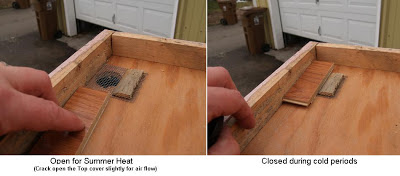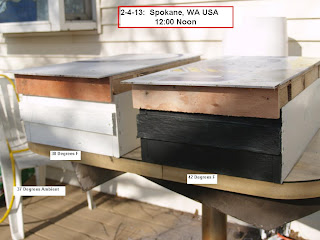My battle with the Varroa!
Perhaps there is no greater threat to
the health of a honey bee colony than an infestation of Varroa mites.
They are responsible for acting as a vector for spreading disease –
maybe even related to the spread of nosema cerenae. Some evidence
I've read points to this pathogen as the cause of CCD. However,
there is much debate and on-going research on this.
There are many products and treatments
that have been introduced lately that help. However, I am committed
to using natural methods. Some of these treatments involve chemistry
that intuitively tells me that it's dangerous for the bees. Plus,
they are usually costly. Many folks would argue that the 'chemical
treatments' are worth it because if you lose a hive, well.... that is
pretty darn costly as well!
I get that and I understand.
But this is where some simple and low
cost methods may prove to be just as effective if not more so.
This is where the 1/8ths inch screen
comes into play.
By using this screen, the bees can walk
across it but if the nasty varroa mite adult falls off while moving
from one bee to another, it will fall through the screen and not be
able to breed and continue the infestation. From some studies that
I've read, this eliminates 30 – 40 % of the mites making the 'load'
manageable with a strong hive.
There is no way for the varroa mite to
develop a 'resistance' to this mechanical type of treatment. I also
think the development of hygienic breeding stock will help. I
currently am breeding a line of bees that have a Russian/Carnolian
genetic background. They are very successful here and I've had great
luck with them and overwintering. I'm looking forward to rearing
more queens this spring using some of the hygienic
Carnolian/Caucasian as breeding drones from Washington State
University stock.
For more tips and techniques - please see Ross Conrad's excellent book on Natural Beekeeping. It is a great resource and it will certainly give you some ideas for dealing with this and other hive pests.
http://www.amazon.com/Natural-Beekeeping-Organic-Approaches-Apiculture/dp/1933392088
For more tips and techniques - please see Ross Conrad's excellent book on Natural Beekeeping. It is a great resource and it will certainly give you some ideas for dealing with this and other hive pests.
http://www.amazon.com/Natural-Beekeeping-Organic-Approaches-Apiculture/dp/1933392088
Click here to see these 'hygienic bees' fighting off the Varroa: http://www.youtube.com/watch?v=xSGa9DKraGA
I feel the combination of these two
things, 'hygienic' bees with the Russian genetics AND the use of
varroa screens, will provide the greatest - most long lasting
strategy for dealing with this darn pest.
Construction Tips:
The screen is the most expensive part
of this. I figured it cost me about .50 cents for the screen. I
bought a large roll of it and cut them to fit my 8 frame equipment.
Using a brad nailer, simply cut some ¼ pine stock strips and apply
them so that your super will 'stand off' from the base of the screen.
This will allow your bees to move freely across the bottom of your
hive – just below the frames.
I am also a believer in using a bottom
entrance – so I make an allowance for that too. This is a
small-ish entrance that allows for ventilation and is easy to guard
when Yellow Jacket season comes along.
I used my 2 inch staple nailer to apply
3 strips of waste wood to act as a base. This is handy for when I
use my hand truck to move populated supers. My back always thanks me
for this!
Have a good day and please don't hesitate to share your ideas too!
We'll talk about my outer or 'weather' covers next week.









